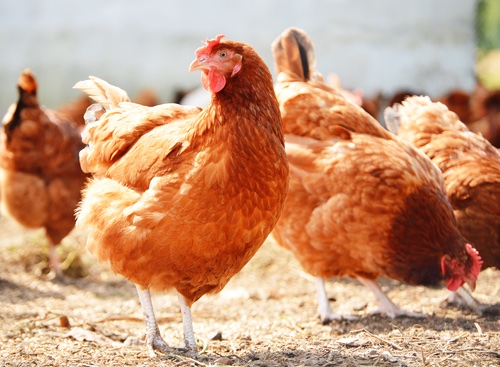NRW denies poultry link to river Wye deterioration, citing out-of-date data

The egg industry supports two million chickens in the Irfon valley alone. The river’s problem comes from their waste.
Photo: Shutterstock./monticello
Natural Resources Wales (NRW) has provoked frustration and incredulity from Fish Legal this month, in concluding that there is no evidence of a deterioration in the status of the river Wye, despite a report on the Ithon, a main tributary of the Wye, which indicates levels of phosphate many times higher than in a healthy protected upland river. That report makes a link between the two million chickens that live in the Ithon valley, the Wye’s pollution and its algal blooms.
In recent years, the Wye has turned green with summer algal blooms, a concerning and visible development over its water quality.
Now, two years after Fish Legal notified NRW that environmental damage is being caused on the Wye by intensive poultry units in Wales, NRW’s conclusion that there is no evidence of a deterioration in the river means there is, therefore, no duty on them to act over the intensive poultry units, which are proliferating in the Wye valley and contributing to phosphate overloads in the river
Expert
The Fish Legal report from an expert ecotoxicologist explained how the poultry units contribute pollution to the Wye and asked NRW to act immediately. However, NRW, relying on data from 2009 to 2015, argued that there is no evidence of a direct relationship between the geographical location of poultry units and the location of failures in the protected site. According to NRW, only one water-body within the Wye catchment– the Afon Chwefru – has been identified as potentially deteriorating.
The river Wye, as an SAC needs to meet favourable conservation status targets. However, NRW has not carried out a review of the status of the SAC since 2009, despite being legally required to do so on a ‘continuing basis’.
Fish Legal’s report was based on more recent surveys and data, including detailed impacts to the Ithon, a main tributary of the Wye in Wales, which indicated levels of phosphate many times higher than in a healthy, protected upland river. With an estimated two million chickens reared across the Ithon catchment, the report makes the link between the pollution and the algal blooms. Despite this expert evidence, NRW has continued to denied any link.
Justin Neal, solicitor at Fish Legal commented, “Most people would understand that you won’t necessarily find a link between elevated phosphate levels at the location of an intensive poultry unit, if the manure from the facility is spread on fields next to the Wye a few miles away – which is what happens at the moment.”
Planning review
Significantly, Fish Legal has applied to the High Court in Cardiff for Judicial Review of a decision by Powys County Council to grant planning permission to double the size of an industrial poultry unit near Builth Wells, which is in the river Wye catchment, from 90,000 birds to 180,000.
It has also raised concerns on behalf of the Kington Fishing Club over another application to increase capacity from 33,000 turkeys to 215,000 chickens at a site in Herefordshire that runs alongside the river Arrow, which also feeds the Wye.
Both actions are focused on the regulators who have taken the decisions which have led to the current state of the river Wye.
Justin Neal, solicitor at Fish Legal summed up anglers’ frustrations adding,“This is a clear example of a regulator burying its head in the sand. There is an army of citizen scientists currently collecting samples and testing water quality on the entire length of the Wye. But NRW aren’t going to take a blind bit of notice of their results. They will continue to rely on their own out-of-date assessments to deny what is glaringly obvious to everyone else: the river Wye as a habitat for wildlife is deteriorating.”



